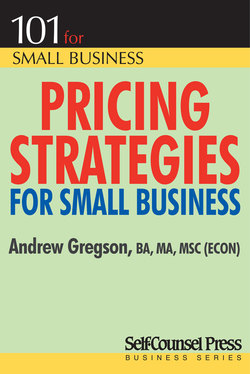Читать книгу Pricing Strategies for Small Business - Andrew Gregson - Страница 4
На сайте Литреса книга снята с продажи.
1 Why Is Pricing Important?
ОглавлениеThe purpose of this book is to help small businesses with a neglected and vexing business problem: how to get prices right. They should be high enough so that the business makes a profit and yet low enough to keep customers coming through the door.
This is a neglected issue since most publications on this topic are for scholarly consumption, but judging by the current flurry of articles and books, pricing is becoming the next big business topic. Most of the books and articles I read for my research on pricing methods are struggling to find a framework for a new pricing “system.”
This is also a neglected topic since most publications are directed at big businesses and draw most of their examples from huge corporations. There may be similarities in pricing logic between General Electric and the corner shop selling used clothing, but the similarities do not immediately rush out and take you by the hand.
Pricing is a vexing subject. Have you ever had customers respond badly to your pricing structure? Having a customer walk out or outright declare that your price is a “rip-off” is a horribly discouraging experience typically accompanied by a sick feeling in the pit of your stomach.
How do you get the pricing right, while in most markets there is competition from big-box giants like Wal-Mart or from chains bringing in Chinese-made goods, reducing your most profitable lines to a commodity that is bought and sold on the world stage based on price and nothing else?
“All too frequently, executives will complain about price problems and price pressures, but are these are rarely mere pricing
problems. They usually deal with communication, branding, image, product, distribution, service excellence, segmentation, and other ill-conceived, ignored or poorly executed functions of a marketing strategy that isn’t focused on value.”[1]
When you are finished reading this book, you will have a working knowledge of many different pricing mechanisms. Moreover, you will have the tools to examine your own business to enable you to measure the impact of a new pricing scheme. But best of all, you will have many pricing options to choose from, options that will help you to set prices so that your business will clobber the competition.
When I began preparing this book for publication, I began with my consulting experience for small companies that had not yet got the basics right. For the most part my clients didn’t grasp their real costs. Bidding on a job was something that happened on some distant planet in their imaginations, and bore no resemblance to the real world of their shop floors. A lot of my book is focused on helping small business owners to understand their costs and learn how to measure them.
As I have done my research for this book, I have dramatically expanded the value-added portion of pricing theory. In the past decade, pricing theory has reappeared in academic journals. The thrust of the research is no longer concerned with costs but with adding perceived value. The assumption is that the company knows its costs and as long as it covers its costs, it can proceed to add value by raising prices. I have used this information greedily.
If you read this book completely, you will discover that price is not purely a numbers game. In fact, it is difficult to get away from the notion that price reflects how a business delivers value to its customers. High prices ought to reflect high value. Low prices should reflect commodities with little or nothing injected to add value. Therefore a large portion of this book encourages you, the reader, to review your business as a potential customer would; what value do you offer, how much is that value worth compared to your competition’s offers, and is this transaction a fair trade?
Journeying down the path of price discovery entails looking into many dark and perhaps underperforming corners of the business. Therefore, this book touches on but does not exhaustively examine sales training, merchandising, estimating, motivation and marketing. In each area I have tried to keep the focus of the impact of pricing strategy on areas such as staff motivation, for example, and in reverse the impact of staff motivation on pricing structure.
As a business owner you only have to work half a day, and, better yet, you get to choose which twelve hours. I remember being a small business owner and how true this joke was for me. With that in mind, I have tried to recognize that the average business owner will get maybe five minutes of uninterrupted time to dip into this book and grab a useful idea, or perhaps the inspiration to read a whole chapter at night after business shuts down and everyone has gone to bed.
1. Baker, Ronald J. Pricing on Purpose. Creating and Capturing Value. John Wiley and Sons Inc. Hoboken, New Jersey. 2006
